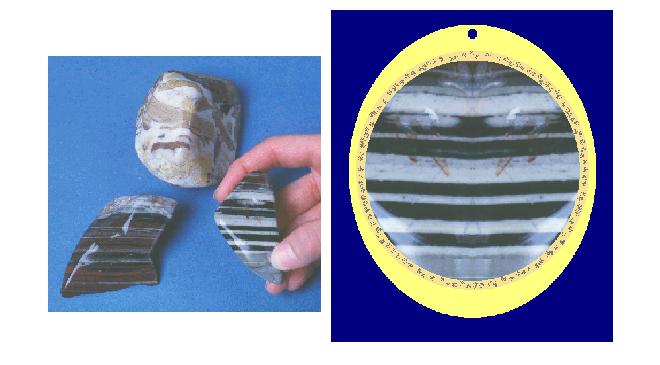(Fr- rhyolite; Ger- Rhyolith;
Nor- rhyolitt/liparitt; Rus-![]() [= liparite]
)
[= liparite]
)
RHYOLITE

A. Rhyolite. Two lower specimens are silicified rhyolites ("Wonderstone") from an unknown locality (thumb and figers give scale). Anna Jonas Stose collection. The top specimen is silicified breccia, not rhyolite, the dark fragments of which are epidote-rich algal-like masses (see Dietrich and Chyi, 1995). R.V. Dietrich collection. (© photo by Dick Dietrich)
B. Rhyolite. Silicified rhyolite (diameter - 6.5 cm) from unknown locality. This illustration is a computer-generated mock up showing how the banded rhyolite (lower right piece in "A") could be used to fashion a book-match pendant. (© photo by Dick Dietrich)
DESCRIPTION: Rhyolite is the aphanitic
equivalent of granite -- i.e.,
rhyolite has the same general composition as granite but the
individual grains of rhyolite are so small they cannot be distinguished
by the naked eye or even with the aid of a handlens. Many rhyolites, however, contain macroscopic
phenocrysts, and some rhyolites also have natural glass as a
constituent.
Color (i.e.,
the overall color of rhyolites per se
and of the ground masses of rhyolite porphyries) -- light gray, pink,
yellowish,
cream, mauve, tan to medium brown, light to brick-red; mottled
or banded patterns are relatively common.
H. (effective hardness) > 5,
typically 6 - 7
S.G. ~ 2.65
Miscellany -Rhyolites that exhibit certain
kinds of flow banding and/or contain spherulites are the ones used most
frequently as gemrocks.
Many rhyolites are porphyritic with quartz
and salmoncolored K-feldspar plus or minus white to off-white
sodium-rich plagioclase as the most common phenocrysts; identification of the minerals that occur as
phenocrysts in aphanite
porphyries is the
method used by most geologists to name handspecimens of chiefly
aphanitic
rocks in the field. In the
absense of phenocrysts, the overall color is often utilized, but
noted with prduent disclaimers.
OTHER NAMES: ... Rhyolite, with the ellipsis replaced by a geographic designator plus or minus an adjective describing its color or some quality such as its being porphyritic is the way many chiefly rhyolite masses are named to in the geologic literature and on geologic maps. Two examples are the Mule Mountain Rhyolite of southwestern New Mexico and the Balaklala Rhyolite of Klamath Mountains province of California.
A few names given rhyolites that have been used as gemrocks follow:
USES: Jewelry -- especially that including fairly large stones; diverse ornaments.
OCCURRENCES: Most rhyolite occurs as lava flows. Several origins have been suggested to account for the banding of rhyolites designated wonderstone. Any serious consideration of those suggestions is far too long and involved include here; for those who wish to delve further into this subject, one possibly fruitfuI start would be to look up Liesegang banding in geological and chemical data bases.
NOTEWORTHY LOCALITY: Much so-called gem quality rhyolite comes from Australia. A well-known United States locality is near Truth and Consequences, Sierra County, New Mexico.
REMARKS: The name rhyolite, from the
Greek word ρύαξ
(stream) -- ergo,
streaming rock -- was apparently given in allusion to the flow
banding that is so characteristic of much of this rock. This name
was first applied in the literature in 1860 by Baron Ferdinand von
Richthofen, grandfather of the (in)famous World War I pilot, Manfred
von Richthofen, the "Red Baron." Today,
rhyolite is used rather widely as the first term of binomial
rock names -- e.g., rhyolite
porphyry, rhyolite breccia and rhyolite
tuff -- as well as a freestanding noun for rocks of this composition be
they banded or not. The
already mentioned synonym liparite
has also had widespread use, especially in Europe. It was
Introduced in 1861 by Professor Justus Roth of the University of
Berlin for occurrences in the Lipari Islands, off Italy. The
fact that the term rhyolite was introduced a year before liparite gives
it priority so it is generally thought the term liparite should be
abandoned. However, a slight quirk so far as abandoning the
term liparite has been mentioned:
Theophrastus used the term Λιπαραοϛ (liparaios) for stones from
the Lipari Islands that were very likely at least a variety of this
rock. (see Johannsen, 1932, v.II, p.265)
The term rhyolite always comes to my mind
whenever
I think of confusion related to names of rocks. This is so
because i
have found it virtually impossible not to think of the following
descriptio: “Rainforest
Jasper is a beautiful, opaque pastel semi-precious gemstone, displaying
hues of green with occasional clear spots. Referred to as Rhyolite by
Geologists, Rainforest Jasper is really a Granite that has cooled
relatively quickly." (www.luckygemstones.com ) -- Wow!!!
All sorts of problems and
ambiguities attend usage of the term Wonderstone. Indeed,
diverse applications of the term comprise a nomenclature
nightmare. Not only has the name been applied to some so-called
scenic sandstone -- see SANDSTONE entry -- but also
to a jasperized calcareous breccia from the Eagle Peak area of Sierra County, New Mexico. In addition, I suspect that some similar jasperoid
of
the same general region, which has been
given the local name Candy rock (Rouse, 1963.), would be
considered a wonderstone,
at least by connoisseurs of rock candy, eh(?).
The cliff dwellings that are one of the areas
of particular interest in Bandelier National Monument in north central
New Mexico
are in rhyolite tuff. These cavelike dwellings, some of which
have been dated back to the mid 12th century, were occupied by
the Anasazi (ancestral Puiebloans). Some of them are only
slightly
altered natural cavities; others were enlarged by carving into
this relatively soft rock.
SIMULANTS:
None that I have seen or seen described.
REFERENCES: No general reference.
R.V. Dietrich © 2015
Last
update: 2 July 2005
web page created by Emmett Mason